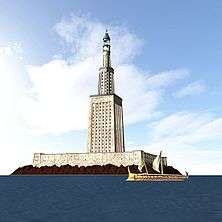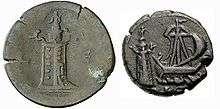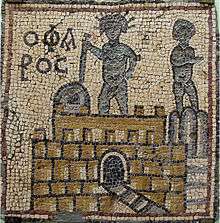Lighthouse of Alexandria
 Drawing by archaeologist Hermann Thiersch (1909) | |
| Location | Pharos, Alexandria, Egypt |
|---|---|
| Coordinates | 31°12′50″N 29°53′08″E / 31.21389°N 29.88556°ECoordinates: 31°12′50″N 29°53′08″E / 31.21389°N 29.88556°E |
| Year first constructed | c. 280 BC |
| Deactivated | 1303/1323 |
| Foundation | Stone |
| Construction | Masonry |
| Tower shape | Square (below), octagonal (middle) and circular (top) |
| Height | 120–137 m (394–449 ft) |
| Range | 47 km (29 mi) |
The Lighthouse of Alexandria, sometimes called the Pharos of Alexandria (/ˈfɛərɒs/; Ancient Greek: ὁ Φάρος τῆς Ἀλεξανδρείας, contemporary Koine Greek pronunciation: [ho pʰá.ros teːs a.lek.sandréːaːs]), was a lighthouse built by the Ptolemaic Kingdom between 280 and 247 BC which was between 120 and 137 m (394 and 449 ft) tall. One of the Seven Wonders of the Ancient World, it was one of the tallest man-made structures in the world for many centuries. Badly damaged by three earthquakes between AD 956 and 1323, it then became an abandoned ruin. It was the third longest surviving ancient wonder (after the Mausoleum at Halicarnassus and the extant Great Pyramid of Giza) until 1480, when the last of its remnant stones were used to build the Citadel of Qaitbay on the site. In 1994, French archaeologists discovered some remains of the lighthouse on the floor of Alexandria's Eastern Harbour.[1] The Ministry of State of Antiquities in Egypt has planned, as of late 2015, to turn submerged ruins of ancient Alexandria, including those of the Pharos, into an underwater museum.[2]
Origin

Pharos was a small island located on the western edge of the Nile Delta. In 332 BC Alexander the Great founded the city of Alexandria on an isthmus opposite Pharos. Alexandria and Pharos were later connected by a mole[3] spanning more than 1200 metres (.75 mi), which was called the Heptastadion ("seven stadia"—a stadium was a Greek unit of length measuring approximately 180 m). The east side of the mole became the Great Harbour, now an open bay; on the west side lay the port of Eunostos, with its inner basin Kibotos, now vastly enlarged to form the modern harbour. Today's city development lying between the present Grand Square and the modern Ras al-Tiin quarter is built on the silt which gradually widened and obliterated this mole, and Ras al-Tiin represents all that is left of the island of Pharos, the site of the lighthouse at its eastern point having been weathered away by the sea.
Construction


The lighthouse was constructed in the 3rd century BC. After Alexander the Great died of a fever at age 32, the first Ptolemy (Ptolemy I Soter) announced himself king in 305 BC, and commissioned its construction shortly thereafter. The building was finished during the reign of his son, the second Ptolemy (Ptolemy II Philadelphus). It took twelve years to complete, at a total cost of 800 talents,[4] and served as a prototype for all later lighthouses in the world. The light was produced by a furnace at the top, and the tower was said to have been built mostly with solid blocks of limestone.
Strabo reported that Sostratus had a dedication inscribed in metal letters to the "Saviour Gods". Later Pliny the Elder wrote that Sostratus was the architect, which is disputed.[5] In the second century AD the satirist Lucian wrote that Sostratus inscribed his name under plaster bearing the name of Ptolemy. This was so that when the plaster with Ptolemy's name fell off, Sostratus's name would be visible in the stone.[6][7]
Height and description
Judith McKenzie writes that "The Arab descriptions of the lighthouse are remarkably consistent, although it was repaired several times especially after earthquake damage. The height they give varies only fifteen per cent from c. 103 to 118 m (338 to 387 ft), on a base c. 30 by 30 m (98 by 98 ft) square."[8]
The fullest description of the lighthouse comes from Arab traveller Abou Haggag Youssef Ibn Mohammed el-Balawi el-Andaloussi, who visited Alexandria in A.D. 1166.[9]
The Arab authors indicate that the lighthouse was constructed from large blocks of light-coloured stone, the tower was made up of three tapering tiers: a lower square section with a central core, a middle octagonal section, and, at the top, a circular section. At its apex was positioned a mirror which reflected sunlight during the day; a fire was lit at night. Extant Roman coins struck by the Alexandrian mint show that a statue of a Triton was positioned on each of the building's four corners. A statue of Poseidon or Zeus stood atop the lighthouse.[10] The Pharos's masonry blocks were interlocked, sealed together using molten lead, to withstand the pounding of the waves.[11]
Al-Masudi writes that the seaward-facing eastern side featured an inscription dedicated to Zeus.[12]

Destruction
The lighthouse was badly damaged in the earthquake of 956, and then again in 1303 and 1323. Finally the stubby remnant disappeared in 1480, when the then-Sultan of Egypt, Qaitbay, built a medieval fort on the larger platform of the lighthouse site using some of the fallen stone.
Recent archaeological research
In 1968 the lighthouse was rediscovered. UNESCO sponsored an expedition to send a team of marine archaeologists, led by Honor Frost, to the site. She confirmed the existence of the ruins representing part of the lighthouse. Due to the lack of specialists and the area becoming a military zone, it would be put on hold.
Greek archaeologists led by Jean-Yves Emperor re-discovered remains of the lighthouse in late 1994 on the floor of Alexandria's Eastern Harbour. Some of these remains were brought up and were lying at the harbour on public view at the end of 1995. A Nova program chronicled the discovery.[1] Subsequent satellite imaging has revealed further remains. It is possible to go diving and see the ruins. The secretariat of the UNESCO Convention on the Protection of the Underwater Cultural Heritage are currently working with the Government of Egypt on an initiative to add the bay of Alexandria (to include remains of the lighthouse) on a World Heritage List of submerged cultural sites.[13]
Significance


Pharos became the etymological origin of the word 'lighthouse' in Greek (φάρος), Persian (Fānūs – فانوس), many Romance languages such as French (phare), Italian and Spanish (faro), Romanian (far) and Portuguese (farol), some Germanic languages like Norwegian (fyr), and even some Slavic languages like Bulgarian (far). In Russian, a derived word means "headlight" (fara – фара).
In 2008 it was suggested[14] that the Pharos was the vertical yardstick used in the first precise measurement of the size of the earth.
Pharos in culture
The lighthouse remains a civic symbol of the city of Alexandria and of the Alexandria Governorate with which the city is more or less coterminous. A stylised representation of the lighthouse appears on the flag and seal of the Governorate and on many public services of the city, including the seal of Alexandria University.
In architecture
- A well-preserved ancient tomb in the town of Abusir, 48 kilometres (30 mi) southwest of Alexandria, is thought to be a scaled-down model of the Alexandria Pharos. Known colloquially under various names – the Pharos of Abusir, the Abusir funerary monument and Burg al-Arab (Arab's Tower) – it consists of a 3-story tower, approximately 20 metres (66 ft) in height, with a square base, an octagonal midsection and cylindrical upper section, like the building upon which it was apparently modelled. It dates to the reign of Ptolemy II (285–246 BC), and is therefore likely to have been built at about the same time as the Alexandria Pharos.
- The design of minarets in many early Egyptian Islamic mosques followed a similar three-stage design to that of the Pharos, attesting to the building's broader architectural influence.[15]
- The George Washington Masonic National Memorial, located in Alexandria, Virginia, is fashioned after the ancient Lighthouse of Alexandria in Egypt.[16]
In books
- Julius Caesar, in his Civil Wars (Part III, 111–112), describes the Pharos and its strategic importance. Gaining control of the lighthouse helped him subdue Ptolemy XIV's armies (48 BC):
Now because of the narrowness of the strait there can be no access by ship to the harbour without the consent of those who hold the Pharos. In view of this, Caesar took the precaution of landing his troops while the enemy was preoccupied with fighting, seized the Pharos and posted a garrison there. The result was that safe access was secured for his corn supplies and reinforcements.[17]
- The Romano-Jewish historian Josephus (37 – c.100 AD) describes it in his book The Jewish War (4.10.5) when he gives a geographical overview of Egypt.
- It was described in the Zhu fan zhi ("Records of Foreign Peoples") by Zhao Rugua (1170–1228), a Chinese customs inspector for the port city of Quanzhou during the Song dynasty.[18]
References
Notes
- 1 2 "Treasures of the Sunken City". Nova. Season 24. Episode 17. Transcript. 18 November 1997. PBS. Retrieved 5 March 2012.
- ↑ "Sunken Ruins of Alexandria Will Be World's First Underwater Museum". Earthables. Retrieved March 27, 2016.
- ↑ Smith, Sir William (1952). Everyman's Smaller Classical Dictionary. J. M. Dent & Sons Ltd. p. 222.
- ↑ Over twenty-three tons of silver. "This was an enormous sum, a tenth of the treasury when Ptolemy I assumed the throne. (In comparison, the Parthenon is estimated to have cost at least 469 talents of silver.)"
- ↑ Tomlinson, Richard Allan (1992). From Mycenae to Constantinople: the evolution of the ancient city. Routledge. pp. 104–105. ISBN 978-0-415-05998-5.
- ↑ Mckenzie, Judith (2007). Architecture of Alexandria and Egypt 300 B.C. A.D 700. Yale University Press. p. 41. ISBN 978-0-300-11555-0.
- ↑ Lucian How to Write History, LXII
"After he [Sostratus] had built the work he wrote his name on the masonry inside, covered it with gypsum, and having hidden it inscribed the name of the reigning king. He knew, as actually happened, that in a very short time the letters would fall away with the plaster and there would be revealed: 'Sostratus of Cnidos, the son of Dexiphanes, to the Divine Saviours, for the sake of them that sail at sea.' Thus, not even he had regard for the immediate moment or his own brief life-time: he looked to our day and eternity, as long as the tower shall stand and his skill abide. History then should be written in that spirit, with truthfulness and an eye to future expectations rather than with adulation and a view to the pleasure of present praise."
- ↑ McKenzie, Judith (2011). The Architecture of Alexandria and Egypt: 300 BC – AD 700. Yale University Press. p. 42. ISBN 978-0300170948.
- ↑ Clayton & Price 1988, p. 153.
- ↑ Haas 1997, p. 144.
- ↑ Beaver, Patrick (1971). A History of Lighthouses. London: Peter Davies Ltd, pp. 10–11. ISBN 0-432-01290-7.
- ↑ Paul Jordan (2014). Seven Wonders of the Ancient World. Routledge. p. 44. ISBN 978-1-317-86885-9.
- ↑ "Museums and Tourism - United Nations Educational, Scientific and Cultural Organization". unesco.org.
- ↑ DIO volume 14 pages 3–12 and page 2 footnote.
- ↑ Petersen A.: Dictionary of Islamic Architecture, page 188. Routledge, 1996.
- ↑ "*Ferris, Gary W. Presidential Places: A Guide to the Historic Sites of U.S. Presidents. Winston-Salem, N.C.: J.F. Blair, 1999. p.21"
- ↑ It was common for Caesar in his writings to refer to himself in the third person
- ↑ Needham, Joseph (1986). Science and Civilization in China: Volume 5, Physics and Physical Technology, Part 3: Civil Engineering and Nautics. Taipei: Caves Books, Ltd. Page 662.
Bibliography
- Al-Bakri; Dozy, Rheinhart P.A.; Goeje, Michael J. de (1866). Description de l'Afrique et de l'Espagne, (Description of Africa and Spain). Leyde, E.J. Brill.
- Clarie, Thomas C. (2009). Pharos – A Lighthouse For Alexandria. Back Channel. ISBN 1-934-58212-3.
- Clayton, Peter; Price, Martin (1988). The Seven Wonders of the Ancient World. Dorset. ISBN 0-880-29393-4.
- Haas, Christopher (1997). Alexandria in Late Antiquity: Topography and Social Conflict. Johns Hopkins. ISBN 0-8018-8541-8.
- Levi-Provençal, Évariste (1935). Une Description Arabe Inédite du Phare d'Alexandrie,(An Unpublished Description of the Lighthouse of Alexandria), extract from Mémoires de l'Institut Francais. unpublished.
Further reading
- Alexandrie la Grande by B. Bernard, Cadogan, Paris, 1956.
- Pharos and Pharillon by E.M. Forster, London, 1923.
- Ptolemaic Alexandria by P.M. Fraser, Oxford, 1972 (rep. 1984).
- Pharos antike Islam und Occident: ein Beitrage zur Architekturgeschichte by H. Thiersch, Leipzig and Berlin, 1909.
External links
| Wikimedia Commons has media related to Lighthouse of Alexandria. |
